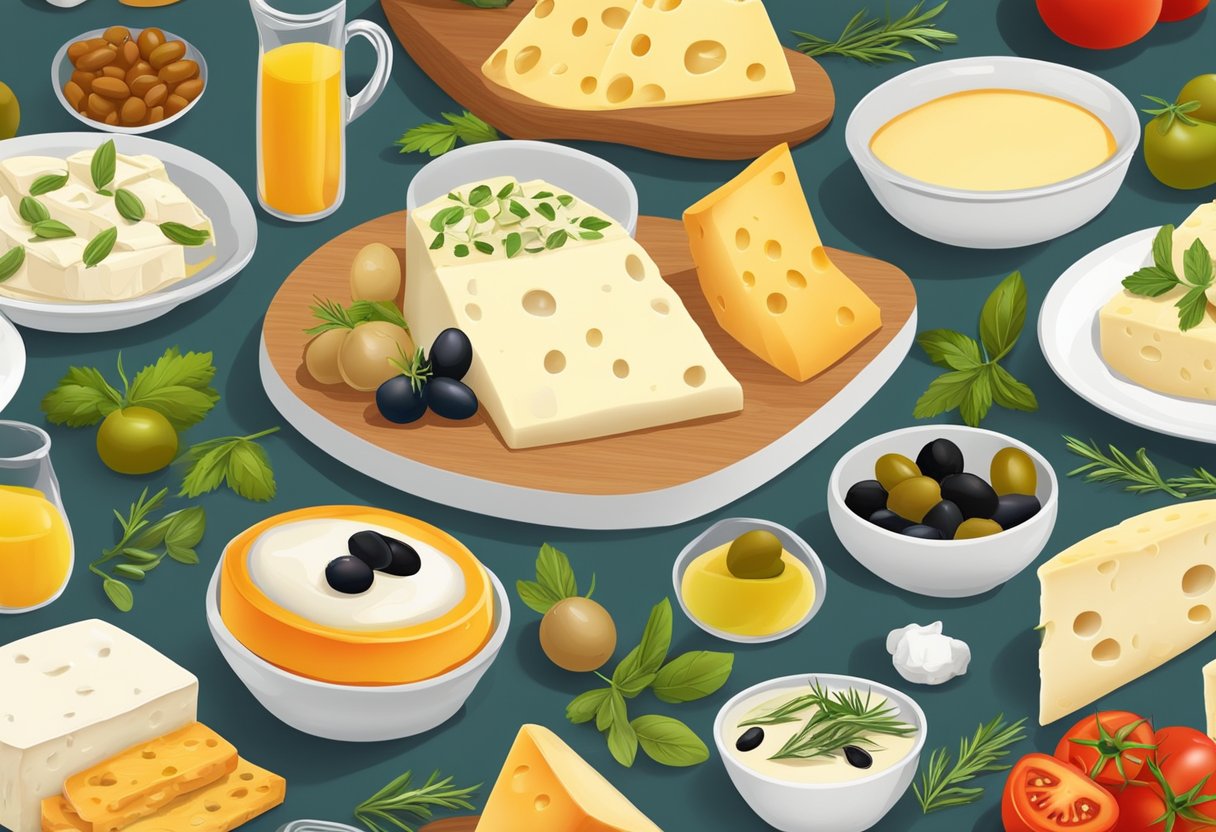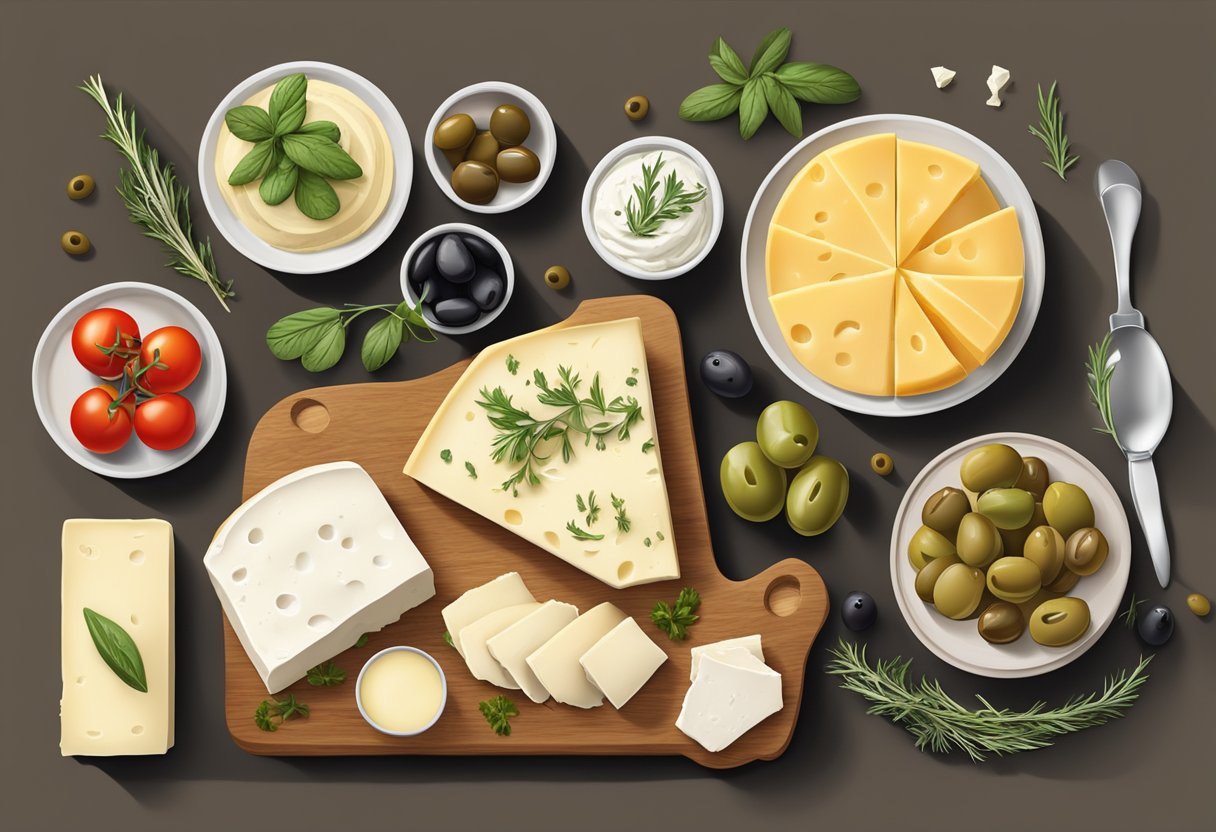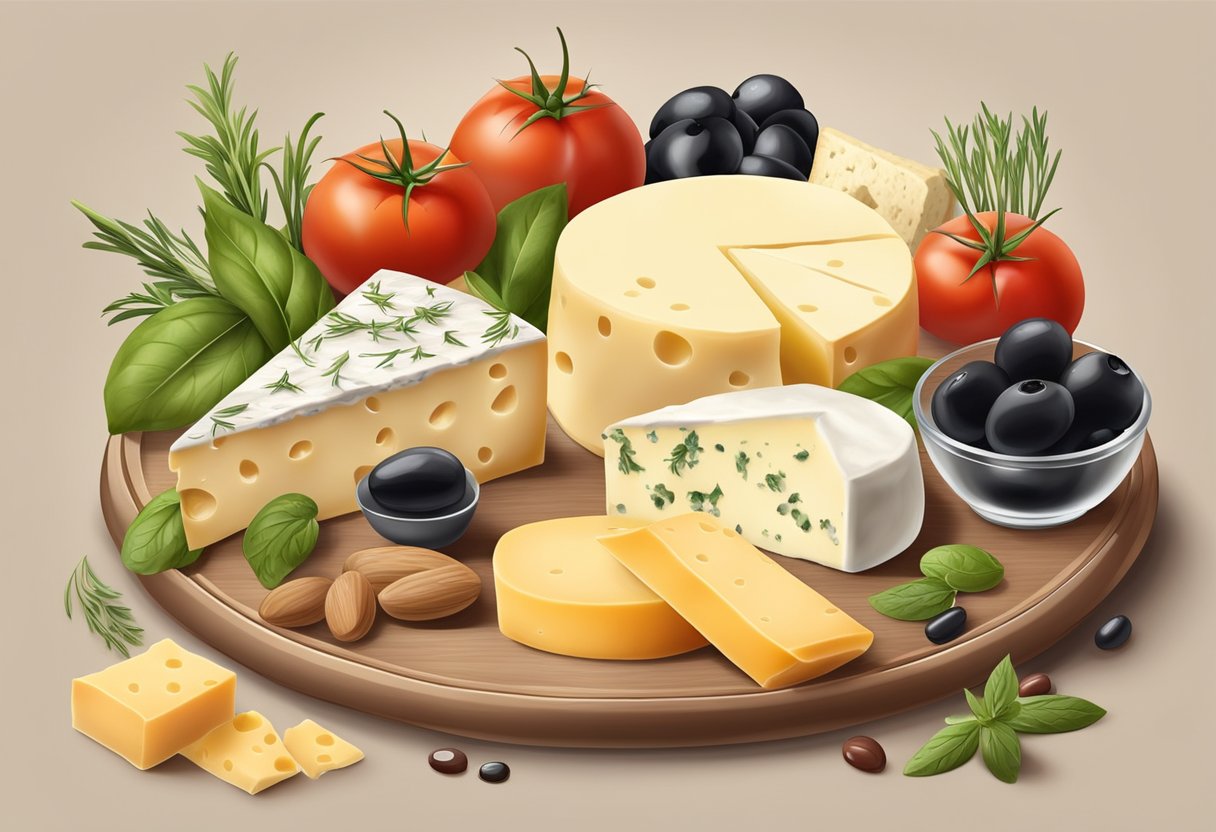Adopting a gluten-free Mediterranean diet is an attractive approach for individuals seeking a balanced yet restrictive nutritional regimen that supports well-being. This lifestyle emphasizes plant-based foods, lean proteins, and healthy fats, all while avoiding gluten, a protein found in wheat, barley, and rye that can trigger health issues for some. Among the respectable components of this diet are high-fat cheeses and creams, which offer a delectable variety to meals without compromising the diet’s core health principles.

Despite the benefits of a gluten-free Mediterranean diet, a common misconception is that it limits the indulgence in richer, more decadent foods like certain dairy products. On the contrary, high-fat cheeses and creams are not only permissible but can also be beneficial. They add both flavor and texture to gluten-free dishes while contributing to satiety and the intake of essential nutrients. With moderation and careful selection, these dairy delights can complement the diet colorfully without derailing nutritional goals.
Key Takeaways
- The gluten-free Mediterranean diet combines nutrient-rich plant foods with the inclusion of high-fat dairy.
- High-fat cheeses and creams enhance flavor and satisfaction in gluten-free recipes.
- These dairy products can be integral to the diet when consumed in moderation and selected judiciously.
Table of Contents
Understanding the Mediterranean Diet

The Mediterranean Diet is a dietary pattern rooted in the traditional eating habits of countries bordering the Mediterranean Sea. Emphasizing natural, nutrient-dense foods, it offers numerous health benefits and is adaptable to a gluten-free lifestyle.
Key Components and Foods
Fruits and Vegetables: A cornerstone of the Mediterranean Diet, these foods provide vitamins, minerals, and fibers. They are consumed in high quantities daily, with an emphasis on a diversity of produce.
Nuts, Seeds, and Legumes: These plant-based protein sources are integral, and they are rich in healthy fats and fibers, which contribute to satiety and heart health.
Whole Grains: In a gluten-free adaptation of the diet, whole grains such as quinoa, buckwheat, and brown rice replace traditional gluten-containing cereals.
Fish and Seafood: Consumed often, at least twice a week, they are pivotal sources of omega-3 fatty acids, known for their anti-inflammatory properties.
Olive Oil: The primary source of added fat is olive oil, rich in monounsaturated fats and a staple in cooking and dressing.
Healthy Fats: Beyond olive oil, avocados and nuts provide valuable unsaturated fats, beneficial for managing blood pressure and reducing inflammation.
Health Benefits Associated with the Diet
Heart Disease and Blood Pressure: Regular consumption of the diet’s key components correlates with a lower risk of heart disease and can aid in blood pressure management.
Diabetes and Weight Loss: Studies suggest that this diet pattern may reduce the risk of type 2 diabetes and assist in weight management, partly due to its emphasis on fiber-rich foods and healthy fats.
Cancer, Cardiovascular Disease, and Stroke: Evidence indicates potential for reducing risks of certain types of cancer, stroke, and overall cardiovascular disease, linked to the diet’s nutrient profile and anti-inflammatory effects.
Gluten-Free Living
When adopting a gluten-free Mediterranean diet, understanding gluten and its effects, particularly for those with celiac disease, can lead to significant health benefits. The use of high-fat cheeses and creams can be adjusted to meet the needs of this dietary model.
What Is Gluten?
Gluten is a group of proteins commonly found in wheat, barley, and rye. Celiac disease is an autoimmune disorder where the ingestion of gluten leads to damage in the small intestine. Avoiding gluten is not only crucial for those with celiac disease, but also for individuals with non-celiac gluten sensitivity. Gluten-free living involves careful replacement of gluten-containing grains with gluten-free whole foods to maintain a balanced diet rich in carbohydrates essential for energy.
Benefits of a Gluten-Free Diet
Adopting a gluten-free diet can lead to multiple health improvements, especially for those diagnosed with celiac disease. A focus on whole foods, such as fruits, vegetables, and gluten-free grains like quinoa and rice, can offer the necessary nutrients while avoiding gluten. For someone needing to shun gluten, the Mediterranean diet, which emphasizes natural and nutrient-dense foods, can be a satisfying and healthy way to eat.
Incorporating High-Fat Dairy into the Diet

In a gluten-free Mediterranean diet, integrating high-fat dairy products like cheeses and creams presents nutritional value and enhances flavor. It requires careful selection and understanding of the roles they play within the dietary pattern.
Types of High-Fat Cheeses
High-fat cheeses, such as Feta, Parmesan, and Mozzarella, offer rich flavors and varying textures. These cheeses are valued for their high protein content and essential nutrients. Feta is a brined cheese with a tangy taste, and it’s traditionally made from sheep’s milk, offering around 75 calories and 6 grams of fat per ounce. Cottage Cheese serves as a creamier option with lower fat content, also chosen for its protein richness. Here’s a quick glance at the fat and calorie content of popular options:
| Cheese Type | Fat per Serving | Calories per Serving |
|---|---|---|
| Feta | 6g | 75 |
| Parmesan | 7g | 110 |
| Mozzarella | 6g | 85 |
Creams and Their Uses
In the gluten-free Mediterranean diet, creams like Greek yogurt and heavy cream are utilized less frequently but contribute significantly to dishes’ creaminess and richness. Greek yogurt can be a substitute for sour cream, offering a tangy flavor, less fat, and more protein. Heavy cream provides a high-fat content and a smooth texture, excellent for sauces and soups. It’s important to use such creams sparingly due to their high calorie and saturated fat content.
Benefits of Dairy Products
Dairy products in the Mediterranean diet supply essential fatty acids such as Conjugated Linoleic Acid (CLA) and saturated fats in moderation. These components may benefit heart health when consumed within recommended limits. Dairy products like cheese and yogurt contribute to a nutritious diet by providing calcium, protein, and other vital nutrients. They should be consumed thoughtfully to maintain the balance of the gluten-free Mediterranean diet.
Nutritional Balance and Moderation
Adopting a gluten-free Mediterranean diet requires careful consideration of nutritional intake, ensuring a balance of essential nutrients while managing caloric and fat consumption.

Managing Fat Intake
On a gluten-free Mediterranean diet, individuals should focus on consuming fats that are heart-healthy, such as those found in olive oil, while limiting high-fat dairy products. Cheeses, although rich in protein and calcium, can also be high in saturated fats and calories; therefore, choosing naturally low-fat cheeses is advisable. For instance, opting for fat-free or 1% milk can significantly reduce fat intake without sacrificing calcium or protein.
Recommended Dairy Choices:
- Fat-free or 1% milk
- Low-fat yogurt
- Low-fat cottage cheese
Items to Limit:
- Whole-fat milk
- Cream
- Cream-based sauces and dressings
Those with concerns about cholesterol levels should pay particular attention to egg yolks, limiting them to no more than 4 yolks per week, as suggested by Cleveland Clinic.
Importance of Fiber and Protein
A well-rounded gluten-free Mediterranean diet not only manages fat intake but also emphasizes the importance of fiber and protein. High-fiber foods like whole grains, vegetables, legumes, and fruits help maintain stable blood sugar levels and provide a range of health benefits, including improved gut health and a reduced risk of chronic diseases such as type 2 diabetes. Fiber is crucial for those on a gluten-free regimen, as it can often be lacking when eliminating gluten-containing grains.
Protein sources in the gluten-free Mediterranean diet are varied, incorporating fish, seafood, and poultry, which provide essential nutrients without high levels of sodium or sugar. These protein-rich foods support muscle health and overall well-being, and when eaten in moderation, contribute to a balanced diet. Red meat is consumed less frequently, aligning with the principle of moderation central to the Mediterranean dietary pattern.
Adapting Recipes for Gluten-Free Needs

Adhering to a gluten-free diet while embracing the heart-healthy principles of the Mediterranean diet involves thoughtful substitutions and a focus on naturally gluten-free foods. The nutritional richness of the Mediterranean diet can be preserved while removing gluten by carefully choosing alternatives for grains and breads and creating balanced meals.
Substituting Grains and Breads
When it comes to grains, the Mediterranean diet often highlights the use of wholesome cereals like wheat and barley; however, for a gluten-free approach, one must seek alternatives. Suitable gluten-free grains include:
- Quinoa: a protein-packed pseudo-grain
- Brown Rice: a whole grain that offers fiber
- Millet: a versatile grain that can mimic couscous
For bread replacements, options are plenty:
- Gluten-Free Bread: choose those made with a base of rice flour or almond flour
- Lettuce Wraps: a fresh and crunchy alternative for sandwiches and burgers
Herbs and spices common in Mediterranean recipes, such as basil, oregano, rosemary, and sage, remain unchanged as they are naturally gluten-free and add depth of flavor.
Creating Balanced Mediterranean Meals
A well-rounded Mediterranean meal emphasizes vegetables, nuts, seeds, and legumes as staple components. One can construct a gluten-free Mediterranean meal by incorporating:
- Vegetables: a colorful array (e.g., bell peppers, eggplants, tomatoes) either raw or roasted with extra virgin olive oil
- Legumes: proteins such as lentils, chickpeas, or beans
- Nuts and Seeds: a source of good fats and textures
- Herbs and Spices: to add layers of flavor without gluten; think garlic, pepper, and the aforementioned herbs
Cooking with high-fat cheeses and creams for those who tolerate dairy can add richness and flavor to dishes while keeping them gluten-free. It’s crucial to use extra virgin olive oil as the fat of choice for authenticity and health benefits.
By focusing on these natural ingredients and the delightful variety of gluten-free grains available, one can enjoy the full spectrum of Mediterranean dishes without the gluten, from appetizers to entrees.
Lifestyle Considerations

The integration of high-fat cheeses and creams into a gluten-free Mediterranean diet requires careful lifestyle considerations, especially concerning physical activity and smart meal planning.
Physical Activity and Diet
Individuals who include high-fat dairy products in their diet must balance their intake with regular physical activity. Exercise plays a crucial role in mitigating the risk of heart disease and diabetes, conditions that can be influenced by diet. Specifically, the Mediterranean diet encourages moderate to high levels of physical activity, complementing the consumption of healthy fats found in cheeses and creams.
Meal Planning Strategies
Strategic meal planning is essential for individuals following a gluten-free Mediterranean diet that incorporates high-fat dairy. Meal plans should emphasize:
- Healthy Fats: Opt for high-fat dairy options like Greek yogurt, which contains probiotics and is a rich source of protein.
- Weight Loss Considerations: Limit the portions of cheeses and creams to help maintain a calorie deficit if weight loss is a goal.
- Balanced Alcohol Consumption: While moderate amounts of alcohol, specifically red wine, may be included, it should be consumed in moderation.
- Diverse Nutrition: Ensure that each meal is balanced with a variety of nutrients, including vegetables, gluten-free whole grains, legumes, and lean proteins.
Incorporating these foods into daily routines will help individuals attain the health benefits associated with the Mediterranean diet while adhering to a gluten-free lifestyle.
Complementary Foods and Ingredients

Incorporating high-fat cheeses and creams into a gluten-free Mediterranean diet calls for careful selection of complementary foods and ingredients that align with the diet’s principles and nutritional benefits.
Pairing Vegetables and Fats
When one incorporates high-fat dairy into their gluten-free Mediterranean meals, they can balance these with a variety of vegetables. Opt for leafy greens, tomatoes, and peppers, which can be drizzled with olive oil, a monounsaturated fat that is heart healthy (The Role of Fats). Another favorable pairing involves mixing avocado slices, rich in omega-3 fatty acids, with feta cheese crumbles for a nutrient-dense salad.
Selecting Healthful Proteins
The diet emphasizes the consumption of lean proteins such as fish, poultry, and eggs, all of which contain essential nutrients and can lessen the reliance on red and processed meats (Protein Choices). Legumes like beans, lentils, and peas offer not only protein but also fiber, making them excellent gluten-free complements to dairy fats.
The Role of Fruits and Nuts
Fruits and nuts play a pivotal role as companion ingredients in the gluten-free Mediterranean diet. They provide natural sweetness without the need for added sugar. For instance, berries and blueberries can be paired with full-fat Greek yogurt for a healthy dessert option. Walnuts and almonds, on the other hand, add crunch and a dose of healthy fats to various dishes (Nuts and Fruits as Snacks). Incorporate these into meals not only for their flavorful contribution but also for their nutritional value, consisting of fiber, vitamins, and minerals.
Health Impact of High-Fat and Gluten-Free Choices

Adopting a high-fat, gluten-free Mediterranean diet can significantly influence one’s heart health, inflammation response, and metabolic balance. Below, current research findings and health outcomes of these dietary choices are explored, focusing on their effects on heart disease, diabetes, weight management, and immune system health.
Research on Heart Disease and Diabetes
High-fat cheeses and creams, when included as part of a balanced gluten-free Mediterranean diet, show ambiguous impacts on heart disease and diabetes. Some studies have indicated that dairy fats may not be as harmful to heart health as previously thought and could protect against type 2 diabetes. For instance, full-fat dairy products contain more fat-soluble vitamins and could be linked to lower blood pressure and reduced diabetes risk. However, it remains crucial to monitor cholesterol levels as they are a risk factor for heart disease.
Impact on Inflammation and Immune System
The role of high-fat, gluten-free products in controlling inflammation and supporting the immune system is becoming increasingly evident. The fats in these dairy products are rich in antioxidants and omega-3 fatty acids, which are known to reduce inflammatory markers and bolster immune response. Following a Mediterranean diet ethos, these high-fat choices should be occasionally included rather than as diet staples to maintain health and metabolic health.
Weight Management and Metabolic Health
In terms of weight loss and metabolic health, a gluten-free Mediterranean diet inclusive of high-fat dairy has been connected with better satiety and potential weight management benefits. The high fat content can lead to a reduced appetite, which in turn may assist in weight control. Moreover, such a diet has been associated with lower blood sugar fluctuations, contributing to better metabolic health and possibly aiding in brain health maintenance due to stabilized glucose levels.
Personalizing the Gluten-Free Mediterranean Diet

Adapting the gluten-free Mediterranean diet to meet one’s unique nutritional requirements and taste preferences is paramount. It involves a careful selection of high-fat cheeses and creams that align with personal health goals and dietary restrictions.
Considering Individual Nutritional Needs
When personalizing this diet, one must consider nutrient densities and daily values. For instance, those with lactose intolerance might opt for lactose-free high-fat cheeses. Alternatively, individuals monitoring calorie intake might choose creams with lower fat content. It’s essential to consult with a healthcare provider to ensure that all dietary choices contribute to one’s overall well-being, particularly when replacing staples like whole grains with their gluten-free counterparts.
Incorporating Personal Food Preferences
Each person’s palate is distinct, with preferences playing a significant role in diet sustainability. To enjoy the benefits of high-fat dairy on a gluten-free Mediterranean diet, consider the following:
- Choose flavorful cheeses such as feta or Parmesan that can be used sparingly yet provide a satisfying taste.
- Explore gluten-free cream sauces made with mascarpone or Greek yogurt for pasta dishes.
- Create a personal cheese platter with a range of textures and flavors, incorporating olives and gluten-free crackers.
By integrating preferred tastes, the diet becomes not only nourishing but also enjoyable.
Frequently Asked Questions

Navigating a gluten-free Mediterranean diet requires understanding which high-fat dairy products can be included. This section answers common questions about cheese and cream usage within the diet’s guidelines.
What cheeses are included in a gluten-free Mediterranean diet?
Cheeses that are naturally gluten-free and suitable for a gluten-free Mediterranean diet include unprocessed options like feta cheese, assuming no gluten-containing additives are present. It’s important to read all labels carefully to avoid cross-contamination.
Is it possible to incorporate high-fat dairy products in a gluten-free version of the Mediterranean diet?
Yes, high-fat dairy products can be included in moderation. Options such as full-fat Greek yogurt and varieties of aged cheeses that are free from gluten can be part of this diet.
How can heavy cream be integrated into a gluten-free Mediterranean diet?
Heavy cream can be used minimally in a gluten-free Mediterranean diet, often as an addition to coffee or in small amounts to add richness to soups and sauces.
Are there gluten-free Mediterranean diet-friendly recipes that include high-fat cheeses and creams?
Certainly, there are numerous recipes that accommodate a gluten-free Mediterranean diet, including salads with high-fat cheeses and meals where a dollop of cream enhances the flavor.
What dairy alternatives are recommended for a gluten-free Mediterranean diet?
Dairy alternatives like almond milk, coconut milk, and cashew cheese, are recommended for those on a gluten-free Mediterranean diet, especially for individuals who are also dairy-free or vegan.
Which high-fat dairy products should be avoided on the Mediterranean diet?
On a traditional Mediterranean diet, high-fat dairy products like butter and certain cream-based sauces are typically avoided due to their saturated fat content. Instead, the focus is on healthier fats, such as olive oil, for cooking and dressing.



